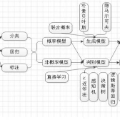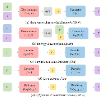We introduce the state-of-the-art deep learning Denoising Diffusion Probabilistic Model (DDPM) as a method to infer the volume or number density of giant molecular clouds (GMCs) from projected mass surface density maps. We adopt magnetohydrodynamic simulations with different global magnetic field strengths and large-scale dynamics, i.e., noncolliding and colliding GMCs. We train a diffusion model on both mass surface density maps and their corresponding mass-weighted number density maps from different viewing angles for all the simulations. We compare the diffusion model performance with a more traditional empirical two-component and three-component power-law fitting method and with a more traditional neural network machine learning approach (CASI-2D). We conclude that the diffusion model achieves an order of magnitude improvement on the accuracy of predicting number density compared to that by other methods. We apply the diffusion method to some example astronomical column density maps of Taurus and the Infrared Dark Clouds (IRDCs) G28.37+0.07 and G35.39-0.33 to produce maps of their mean volume densities.
翻译:我们引入先进的深度学习去噪扩散概率模型(DDPM)作为一种从投影质量面密度图中推断巨型分子云(GMCs)体积或数量密度的方法。我们采用带有不同全局磁场强度和大尺度动力学即非碰撞和碰撞GMCs的磁流体力学模拟。我们对所有模拟使用扩散模型进行质量面密度图和它们对应的权重质量数密度图的训练,这些图来自不同的视角。我们将扩散模型的性能与更传统的两组分和三组分幂律拟合方法以及更传统的神经网络机器学习方法(CASI-2D)进行比较。我们得出结论,与其他方法相比,扩散模型在预测数量密度方面的准确性提高了一个数量级。我们将扩散方法应用于Taurus和红外暗云(IRDCs)G28.37 + 0.07和G35.39-0.33的一些示例天文柱密度图,以生成它们的平均体密度图。



